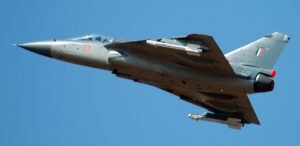India’s HAL Inks $1 Billion Deal with GE Aerospace for 113 Jet Engines
|
General Studies Paper III: Defence Technology, Indigenization of Technology |
Why in News?
India’s Hindustan Aeronautics Limited (HAL) has signed a landmark $1 billion deal with GE Aerospace to acquire 113 jet engines for the Tejas Light Combat Aircraft Programme, marking a significant leap in India’s defence self-reliance journey.

Highlights of the Hindustan Aeronautics Limited (HAL) – GE Aerospace Agreement
- On 7 November 2025, HAL entered into a contract with GE Aerospace for the supply of 113 units of the F404-GE-IN20 jet engine along with a support package.
- The deal is estimated at around US $1 billion (approximately ₹8,870 crore). The engines will serve the indigenous fighter aircraft programme for which HAL is the principal manufacturer.
- The contract aims to power the next batch of the domestically developed fighter aircraft platform, the Tejas Mk‑1A light combat aircraft.
- According to this deal, the deliveries of the 113 engines are scheduled to begin in 2027 and conclude by 2032, a five-to-six-year window for phased engine supplies and integration into the aircraft production line.
Tejas Light Combat Aircraft Programme
-
- The Tejas Light Combat Aircraft (LCA) is India’s indigenous fighter aircraft developed to replace the ageing MiG-21 fleet of the Indian Air Force (IAF).
- The project began in 1983 under the Light Combat Aircraft Programme, which was initiated by the Government of India to create a modern, lightweight, multi-role fighter.
- The Aeronautical Development Agency (ADA) was formed under the Defence Research and Development Organisation (DRDO) to manage its design and development, while Hindustan Aeronautics Limited (HAL) became the main production partner.
- The design work started in the mid-1980s with the goal of creating a supersonic fighter capable of performing both air-to-air and air-to-ground missions. The first technology demonstrator, TD-1, had its maiden flight on January 4, 2001, marking a key milestone in Indian aerospace history.
- The Tejas was cleared for Initial Operational Clearance (IOC) in January 2011 and received Final Operational Clearance (FOC) in February 2019, making it combat-ready for full deployment.
- In 2025, the IAF signed a deal with HAL for 97 Tejas Mk-1A aircraft, raising the total number to 180 units. The first Tejas squadron, No. 45 Flying Daggers under this project, was established in July 2016 at Sulur Air Base in Tamil Nadu.
What is Tejas Light Combat Aircraft (LCA)?
- About: Tejas is India’s first indigenously developed Light Combat Aircraft (LCA), designed by the ADA and produced by HAL. It features advanced avionics, composite materials, and controls for high agility. The aircraft’s name “Tejas”, meaning “radiance” in Sanskrit, was officially given by Prime Minister Atal Bihari Vajpayee in 2003. Tejas symbolizes India’s progress in aerospace technology, representing a major milestone under the Make in India and Atmanirbhar Bharat initiatives.
-
- Features: The Tejas LCA is a single-engine, delta-wing, multirole fighter designed for agility and speed.
- It is powered by the GE F404-IN20 engine, giving it a maximum speed of around Mach 1.8 and a combat range of approximately 500 kilometres.
- The aircraft features fly-by-wire controls, composite airframe, and glass cockpit systems, which enhance maneuverability and reduce radar visibility.
- Its structure uses about 45 percent composite materials, which reduce weight and improve durability.
- It can carry precision-guided munitions, short and beyond-visual-range missiles, bombs, and rockets, making it capable of handling multiple combat roles.
- Around 70 percent of its components are manufactured in India, including avionics, flight control systems, and composite structures.
- It can operate from short runways and is capable of carrying 3.5 tonnes of external payload, including missiles such as Astra, Derby, and Python-5.
- Its EL/M-2052 AESA radar, advanced electronic warfare suite, and modern cockpit systems allow pilots to handle multiple threats with precision.
- Several countries have shown interest in the Tejas LCA, including Malaysia, Argentina, Egypt, and the Philippines.
- Features: The Tejas LCA is a single-engine, delta-wing, multirole fighter designed for agility and speed.
- Variants: There are three main variants in the Tejas family.
- The Tejas Mk-1 is the baseline version currently operational with the IAF.
- The Tejas Mk-1A, approved in 2021, includes upgraded avionics, radar, electronic warfare systems, and a mid-air refueling probe.
- The Tejas Mk-2, under development, will be a larger and more powerful fighter equipped with the GE F414 engine. It is expected to make its first flight by 2026 and enter production around 2028.
- There is also a Naval LCA Tejas designed for Indian Navy aircraft carriers, tested on the INS Vikramaditya and INS Vikrant platforms.
Significance of the HAL–GE Aerospace Deal
- India’s Self-Reliance: The HAL–GE Aerospace deal marks a major milestone in India’s long-term goal of achieving self-reliance in defence production. India has been working toward reducing dependence on imported equipment since 2020. This step helps India build a foundation for producing and maintaining its own combat aircraft engines in the future. Such initiatives reflect India’s growing confidence in designing and producing advanced systems for its armed forces.
- Technology Transfer: The agreement between HAL and GE Aerospace includes plans for technology sharing and joint production of jet engines for the Tejas LCA. This collaboration will provide HAL with exposure to advanced materials, turbine design, and precision manufacturing methods. This will help India to develop high-performance engines for future aircraft like the Tejas Mk-2 and the Advanced Medium Combat Aircraft (AMCA).
- Employment: The large-scale production and maintenance will create a wave of employment in India’s defence and manufacturing sectors. According to HAL’s estimates, each major aircraft project generates thousands of direct and indirect jobs. This includes engineers, technicians, quality inspectors, and software specialists involved in assembly and testing. The deal will also lead to skill development programs in collaboration with technical institutes and training centres.
- Economic Growth: The project will generate a multiplier effect across India’s industrial economy by boosting demand for raw materials, machining, electronics, and testing equipment. Local suppliers of metals, precision tools, and electronic systems will benefit. The development of this ecosystem will attract more foreign direct investment (FDI) into India’s defence manufacturing sector. It will also encourage partnerships between public and private enterprises.
India–US Defence Relations
- India and the United States signed a 10-year defence framework in 2025 that aims to deepen the bilateral strategic partnership and unify policy direction across a broad range of military and industrial domains. The pact includes enhanced collaboration in technology-sharing, joint research, and increased coordination in the aerospace and defence manufacturing sectors.
- Despite the US imposing steep tariffs—doubling to about 50 % on certain Indian exports in 2025—India-US defence cooperation has remained largely unaffected in terms of ongoing deals. The juxtaposition shows that while economic disagreements persist, strategic defence ties have been maintained as a separate pillar.
- Also, in recent years, both countries have worked to build a deeper defence and technology relationship under frameworks like COMCASA (2018), LEMOA (2016), and BECA (2020), which allow greater coordination in military logistics, communications, and geospatial data sharing.
- The recent agreement enhances cooperation in the Indo-Pacific region, where both nations share common goals of maintaining stability and freedom of navigation. The United States has encouraged India to play a more active role in regional security through platforms like the Quadrilateral Security Dialogue (QUAD), which includes Japan and Australia.
- Both sides are also exploring future cooperation in next-generation technologies such as jet propulsion, space systems, artificial intelligence, and cybersecurity under the Initiative on Critical and Emerging Technologies (iCET) launched in 2023.
|
Also Read: HAL and Russia’s PJSC-UAC Join Hands to Build SJ-100 Passenger Aircraft in India |









